
295
JOURNAL OF SCIENCE AND TECHNOLOGY DONG NAI TECHNOLOGY UNIVERSITY
Special Issue
FACTORS OF LOGISTICS SERVICE PROVIDERS EVALUATION
AND SELECTION
Nguyen Tan Huynh*
Dong Nai Technology University
*Corresponding author: Nguyen Tan Huynh, huynhtannguyen@dntu.edu.vn
1. INTRODUCTION
It is agreed that logistics service providers
(LSPs) in today's globalized economy play a
pivotal role in the supply chain networks of
companies across various sectors (Balmer et al.,
2020; Zailani et al., 2018). Besides, the
effectiveness and efficiency of LSPs directly
impact business operations (Chen et al., 2019),
customer satisfaction (Jazairy & von Haartman,
2020), and market competitiveness (Liu et al.,
2018). According to Sarabi and Darestani
(2021), as supply chains become more complex
and customer expectations rise, the need for
comprehensive evaluation and strategic
selection of LSPs becomes crucial. Thus, this
research is motivated by the necessity to
understand and systematize the factors that
influence the selection of LSPs, aiming to
provide businesses with a framework for
making informed decisions that align with their
operational goals and market demands.
Next, the expansion of global trade has
increased the geographical dispersal of
production and consumption, necessitating
sophisticated logistics solutions. Cichosz et al.
(2020) pointed out that companies are no longer
confined to local or regional markets.
Alternatively, they operate on a global scale,
where the efficiency of transporting goods
determines their ability to compete and thrive.
Thence, addressing LSP selection factors is
essential for businesses aiming to capitalize on
GENERAL INFORMATION
ABSTRACT
Received date: 11/03/2024
This study aims to identify and analyze the key factors
influencing the decision-making process for the selection of
logistics service providers (LSPs) via multiple-criteria
decision analysis (MCDA). From a comprehensive literature
review and empirical data gathered through surveys and
interviews with supply chain managers across various
factories in the Bien Hoa industrial zone, this research
categorizes the evaluation criteria into five main factors: cost
efficiency, service quality, capability, reliability, and
sustainability and ethics. This paper also contributes to the
logistics field by providing a structured framework for LSP
evaluation that can be helful for LSPs in optimizing their
supply chain decisions. The study’s implications extend to
enhancing logistical collaborations and promoting sustainable
business practices within the global supply chain landscape.
Revised date: 19/05/2024
Accepted date: 13/07/2024
KEYWORD
Cost efficiency;
Logistics service providers;
MCDA;
Service quality;
Sustainable.

JOURNAL OF SCIENCE AND TECHNOLOGY DONG NAI TECHNOLOGY UNIVERSITY
296
Special Issue
global growth opportunities while managing
risks effectively.
(Singh et al. 2022) argued that supply
chains become more intricate, characterized by
a multitude of interdependencies, so the role of
LSPs becomes more critical than ever. It has
been postualted that modern supply chains are
not just about transporting goods from one
place to another but involve managing complex
inventories, thus providing value-added
services (Laari et al., 2018), and ensuring real-
time data flow across stakeholders (Vu et al.,
2020). Hence, identifying LSPs selection
factors can offer not only transportation
solutions but also comprehensive logistics
services for advanced supply chain practices
(Gupta et al., 2023).
Additionally, the rapid advancement of
technology, particularly in areas like artificial
intelligence, blockchain, and the Internet of
Things (IoT), has transformed logistics
operations (Sureeyatanapas et al., 2018; Zailani
et al., 2018). These technologies promise
transparency (Prataviera et al., 2023), thus
improving transaction efficiency, and reducing
costs for firms (Świtała et al., 2018). However,
they also require LSPs to continually adapt and
innovate. Accordingly, evaluating LSPs based
on their technological capabilities is
increasingly becoming more important than it
used to be.
Moreover, cost efficiency in an
economically fluctuating environment remains
a critical factor for businesses in maintaining
profitability (Oláh et al., 2018). This research
explores how economic pressures influesnce
the prioritization of cost-related factors in the
selection of LSPs. Besides, understanding the
balance between cost and quality is crucial for
businesses in achieving long-term
sustainability in their operations. Dovbischuk
(2022) also had a similar opinion.
To fill the literature gap, this paper aims to
assess factors of logistics service providers
(LSPs) evaluation and selection by the MCDA
approach. In doing so, this paper first identifies
main factors and subfactors affecting logistis
firms' attitude in selecting their LSPs. Then, the
MCDA techniques are used to calculate the
weight of such factors and subfactors. Finally,
some factories in the Bien Hoa industrial zones
are empirical surveyd to verified the proposed
research model.
2. METHODOLOGY
2.1. Identifying factors of LSPs evaluation
and selection
Based on the literature review as noted
earlier, this study identifies five main factors
and twenty subfactors affecting logistis firms'
attitude in selecting their LSPs, including cost
efficiency, service quality, capability,
reliability, and sustainability and ethics. Note
that such factors and subfactors represent
overall capacities of LSPs in delivering their
services to their customers.
2.2. Data collection
In order to verify the proposed research
model, this paper selected a research sample
from factories in the Bien Hoa industrial zones.
Through two rounds of survey, the research
team interviewed seventeen respondents to get
information on factors and subfactors, as seen
in
Table 1. The respondents' profile is seen in
Table 2.

297
JOURNAL OF SCIENCE AND TECHNOLOGY DONG NAI TECHNOLOGY UNIVERSITY
Special Issue
Table 1. Factors and subfactors of LSPs selection
Factors
Subfactors
Codes
Cost efficiency (CE)
Freight rates
CE1
Fuel charges
CE2
Volume discounts
CE3
Billing accuracy and flexibility
CE4
Service quality (SQ)
Timeliness
SQ1
Damage control
SQ2
Packaging and storage
SQ3
Customer service
SQ4
Operating capability (OC)
Transportation modes
OC1
Technological infrastructure
OC2
Coverage area
OC3
Handling special requirements
OC4
Reliability (RL)
Consistency
RL1
Contingency management
RL2
Risk management
RL3
Financial stability
RL4
Sustainability and ethics (SE)
Environmental practices
SE1
Ethical practices
SE2
Corporate social responsibility (CSR)
SE3
Compliance
SE4
Table 2. The sample's descriptive statistics
Features
Frequency
%
Types of
firms
Multinational firms
6
35.29
Domestic firms
9
52.94
Joint-venture
2
11.76
Years of
founding
(years)
<3
2
11.76
3-5
4
23.53
6-9
7
41.18
>9
4
23.53
Productio
n areas
Consumer Goods
7
41.18
Industrial goods
3
17.65
Pharmaceuticals and chemicals
5
29.41
Food and beverages
2
11.76

JOURNAL OF SCIENCE AND TECHNOLOGY DONG NAI TECHNOLOGY UNIVERSITY
298
Special Issue
2.3. The MCDA approach
This paper adopts the MCDA approach to
estimate the weight of factors and
subfactor, as shown in
Table 1. The process for applying this
method is as follows:
Step 1: Establish the fuzzy positive
reciprocal matrix
Suppose we have
A
~
a fuzzy positive
reciprocal matrix with n factors as:
1 ...
~~
: : :
~
... 1
~
~
...
~
1
]
~
[
~
2 1
221
112
nn
n
n
nnij
aa
aa
aa
aA
Where:
ij
a
~
is a triangular fuzzy number
(TFN) with some features:
if ],
1
,
1
,
1
[
if 1], 1, ,1[
if , ] , ,[
~
ji
lmu
ji
jiuml
a
jijiji
ijijij
ij
.
Step 2: Forming integrated FPRM
From the sample of t respondents, we can
build t individual FPRM. Then integrated
FPRMs can be constructed by:
[lij ,mij ,uij ]=min
1£k£taij
(k)
( )
,Pk=1
t
aij
(k)
æ
è
ç
ö
ø
÷
1/t
,max
1£k£taij
(k)
( )
é
ë
ê
ê
ù
û
ú
ú
i=1,2,...,n
,
j=1,2,...,n
and
k=1,2,...,t
.
Note that experts rate the importance weight
of factors and subfactors based the linguistic
scale, as follows:
Table 3. Linguistic terms for the MCDA approach
Linguistic
Term
Numerical
Value
Description
Equal
Importance
1
Both elements
contribute equally to
the objective.
Moderate
Importance
3
One element is
slightly more
important than the
other.
Strong
Importance
5
One element is
strongly more
important than the
other.
Very Strong
Importance
7
One element is very
strongly more
important than the
other.
Extreme
Importance
9
One element is
extremely more
important than the
other.
Intermediate
Values
2, 4, 6, 8
Values used for
compromises
between the adjacent
judgments.
Step 3: Build geometric means for matrixes
For the ith AC (
ni ,...,2,1
) in the matrix
A
~
, its geometric means
i
g
~
may be computed, as
follows:
niumlag
n
ij
n
j
n
ij
n
j
n
ij
n
j
n
ij
n
j
i,...,2,1 , , ,
~~ /1
1
/1
1
/1
1
/1
1
And:
Then, the weight
i
w
~
for the ith factor
can then be obtained as:
ni
l
u
m
m
u
l
ggw n
i
n
ij
n
j
n
ij
n
j
n
i
n
ij
n
j
n
ij
n
j
n
i
n
ij
n
j
n
ij
n
j
n
i
iii ,...,2,1 , , ,
~
/
~~
1
/1
1
/1
1
1
/1
1
/1
1
1
/1
1
/1
1
1

299
JOURNAL OF SCIENCE AND TECHNOLOGY DONG NAI TECHNOLOGY UNIVERSITY
Special Issue
Step 4: Defuzzification
Let
] , ,[
~w
i
w
i
w
ii umlw
, where:
ni
l
u
m
m
u
l
n
i
n
ij
n
j
n
ij
n
j
n
i
n
ij
n
j
n
ij
n
j
n
i
n
ij
n
j
n
ij
n
j,...,2,1 , , ,
1
/1
1
/1
1
1
/1
1
/1
1
1
/1
1
/1
1
The Buckley's index (1981) of the
i
w
~
,
ni ,...,2,1
, is defined as:
wi=li
w´mi
w
( )
2´ui
w
é
ë
êù
û
ú
1
4
,
ni ,...,2,1
Step 5: Normalization:
Normalizing the
i
w
(
ni ..,2,1
), the crisp
weight
i
of the ith factor can then be found as:
n
i
iii ww
1
/
,
ni ,...,2,1
Step 6: The FPRM's consistency
This paper adopts the formula developed by
Wang and Lin (2017) to test FPRM's
consistency, as follows:
Let be the
integrated FPRM, then its geometric
consistency index
GCI
( )
is defined as:
Note that the
GCI
thresholds is as follows:
GCI =
0.3147 if n=3
0.3562 if n=4
0.3700 if n>5
ì
í
ï
î
ï
3. FINDINGS AND DISCUSSION
3.1. The weight of factors and subfactors
Table 4 exhibits empirical results for factors
and subfactors. Some discussion is as follows:
The weight of cost efficiency is 21.96%,
which is second-most important among five
factors in the sample. This factor is divided into
four sub-factors. The most significant sub-
factor is CE4 with a global weight of 9.25%,
which suggests it's the most critical aspect
within the cost efficiency category. CE2 also
carries significant weight at 5.90%. This
distribution indicates a prioritization of certain
cost factors (likely reflecting elements such as
volume discounts or billing accuracy) over
more basic elements like CE1 (3.11%).
The weight of service quality weigh is
28.38%, which is most important in the sample.
This is the highest weighted factor, indicating
its paramount importance in logistics provider
selection. Service quality is often regarded as
the most important factor in selecting LSPs due
to several critical impacting a company's
operations (Liu et al., 2018), customer
satisfaction (Sarabi & Darestani, 2021), and
overall competitiveness (Cichosz et al., 2020).
On top of that, Singh et al. (2022) argued that
high service quality is not just about meeting
current needs but also about preparing for
future challenges and opportunities, making it
an indispensable criterion in SLP selection.
Among four subfactors of this factor, SQ4
stands out with a very high weight of 12.18%,
signaling that this sub-factor, which related to
customer service (Chen et al., 2019) or delivery
accuracy (Laari et al., 2018), is extremely
critical. Besides, SQ1 also has a substantial
impact at 5.33%.
The weight of operating capability is
16.45%. Its subfactors reflects operational
aspects with OC4 being exceptionally dominant
at 8.76%. This suggests that whatever OC4
represents (likely a crucial operational
parameter like technological capability or
geographical coverage) is highly valued.



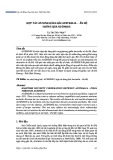
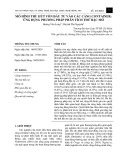
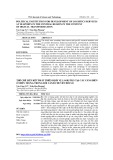
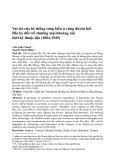

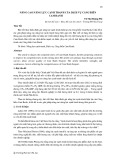
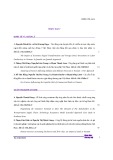







![Đề kiểm tra Quản trị logistics [mới nhất]](https://cdn.tailieu.vn/images/document/thumbnail/2025/20251015/2221002303@sv.ufm.edu.vn/135x160/35151760580355.jpg)
![Bộ câu hỏi thi vấn đáp Quản trị Logistics [năm hiện tại]](https://cdn.tailieu.vn/images/document/thumbnail/2025/20251014/baopn2005@gmail.com/135x160/40361760495274.jpg)







